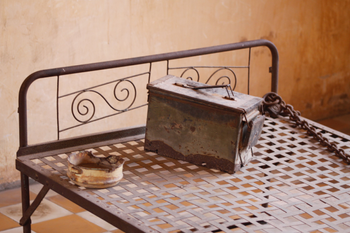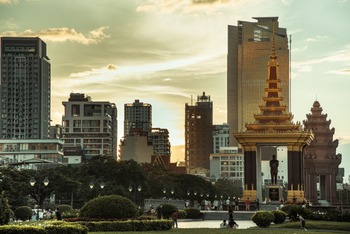Cambodia: More history

The Southeast Asian Kingdom of Cambodia, with a population of nearly 17 million, is located on the Gulf of Thailand and shares borders with Thailand, Vietnam and Laos. Cambodia is best known for its landmark Angkor Wat temple complex near present-day Siem Reap. It is the largest temple complex in the world and attracts millions of tourists from all over the world every year. Once dedicated to the Hindu gods, Khmer culture became increasingly influenced by Buddhism. To this day, Buddhism remains the predominant religion in Cambodia. Angkor was the center of the Khmer Empire from the 9th century onward, and over the centuries grew into a megacity through advanced irrigation systems. Overgrown by jungle, Angkor was rediscovered as recently as 1860, and it was only a few years ago that researchers discovered even more huge remains of settlements through aerial laser scans, which again overturned previous estimates of Angkor's size. Researchers are nowadays speaking of up to 900,000 inhabitants at Angkor's peak - for comparison, Paris was considered the largest city in Europe in the 13th century with 100,000 inhabitants!
Many of the handicrafts flourished during this period, but some have their origins even much earlier. Silk weaving in Cambodia probably dates back to before the 6th century. The cultivation of pepper and other agricultural products has also been practiced for many centuries. Influenced by the rich cultural history, silversmiths, woodcarvers, sculptors or basket weavers in Cambodia are still working according to the methods of their ancestors.
Photo by Paul Szewczyk on Unsplash

The Khmer Empire once stretched across large parts of present-day Thailand, Laos, Vietnam and Myanmar to Malaysia. Shifts in power and various conflicts, especially with Thai tribes in the 13th and 14th centuries who wanted to shake off Khmer rule, eventually led to the collapse of the Khmer Empire. The following centuries were marked by various conflicts with and dependencies on the Thai and Vietnamese in particular. Finally, Cambodia turned to France, which had colonial interests especially in Vietnam. In 1863, France declared Cambodia a protectorate and later integrated it into French Indochina.
It was not until 1954 that Cambodia was granted full sovereignty at the Geneva Indochina Conference. Cambodia had become independent and initially focused on maintaining neutrality. However, conflicts in Southeast Asia intensified, especially in neighboring Vietnam. After General Lon Nol took power in 1970, Cambodia finally joined the United States, Thailand and South Vietnam in the Indochina conflict and was now in the middle of the war. The North Vietnamese Army and the Viet Cong established supply routes in Cambodia and by 1971 were already controlling almost the entire country. The U.S., in turn, bombed Cambodia with over 500,000 tons of bombs in three years, devastating entire territories. After the withdrawal of the major powers in 1973, the conflict continued, with the Khmer Rouge, supported by the People's Republic of China, engaged in fierce fighting with government troops of the U.S.-backed Lon Nol regime. The Khmer Rouge marched into the capital Phnom Penh in 1975 and were celebrated by many as liberators. But this was only the beginning of what is arguably the darkest chapter in recent Cambodian history.
Photo by Sergio Capuzzimati on Unsplash

The Khmer Rouge wanted to turn Cambodia into a communist peasant state that would be largely independent from foreign countries. They closed the borders, cut off communications with the outside world and forced the urban population out onto the countryside, where they had to build huge irrigation systems. Money and all property were abolished, practicing religion was prohibited. Artists, political opponents, intellectuals were systematically murdered. Speaking a foreign language or wearing glasses was enough to be cruelly tortured or directly executed by the Khmer Rouge. Places like the Tuol Sleng Genocide Museum (or S-21), a former high school that had been converted into a torture prison, or the Killing Fields, where the probably more than 17,000 former inmates were systematically murdered, bear witness today to the unimaginable cruelty of this time. The Killing Fields are only one of over three hundred sites where the Khmer Rouge carried out mass murders of its own population. The Khmer Rouge's reign of terror claimed the lives of over two million Cambodians between 1975 and 1979 - about a quarter of the entire population at the time. After unsuccessful attacks in border areas of Thailand and Vietnam, the Vietnamese army (by then South and North Vietnam had reunited as the Socialist Republic of Vietnam) invaded Cambodia and occupied the country in short order.
The Khmer Rouge then took refuge in hard-to-reach mountainous regions and launched a guerrilla war against the occupiers. Cambodia continued to be a pawn in the hands of the powerful, who supported different sides. As a matter of fact, the Khmer Rouge continued to be the UN-recognized government of Cambodia until the late 1980s. More and more, however, the atrocities committed by the Khmer Rouge were brought to light. The Khmer Rouge fought bloody battles with the government until 1996. After a UNTAC mission, Cambodia was placed under UN supervision. In 1993, the first free elections in over 20 years took place. The country received a new constitution and Norodom Sihanouk became king again. In 1998, Cambodia became fully independent.
Photo by binh dang nam on Unsplash

Today, Cambodia is considered a developing country. It is the result of decades of (civil) wars, occupations and the auto-genocide of the Khmer Rouge. It was and still is particularly difficult to prove ownership of land. The Khmer Rouge annulled all private property, expelled the population and tore families apart. Cambodia is still one of the poorest countries in South East Asia. However, the country is slowly recovering and Cambodia's economy has been growing steadily for years (except for the Corona period). Even though there is still much to be reappraised and many difficulties exist on the political level, the people of Cambodia are looking forwards. Art, culture, ancient traditions are being revived and the country is slowly experiencing again what it is like to live in freedom. Tourism is developing rapidly, not only the Angkor Wat temple complex attracts millions of tourists every year. Cambodia is a beautiful country and the people are extremely hospitable.
Photo by Roth Chanvirak on Unsplash